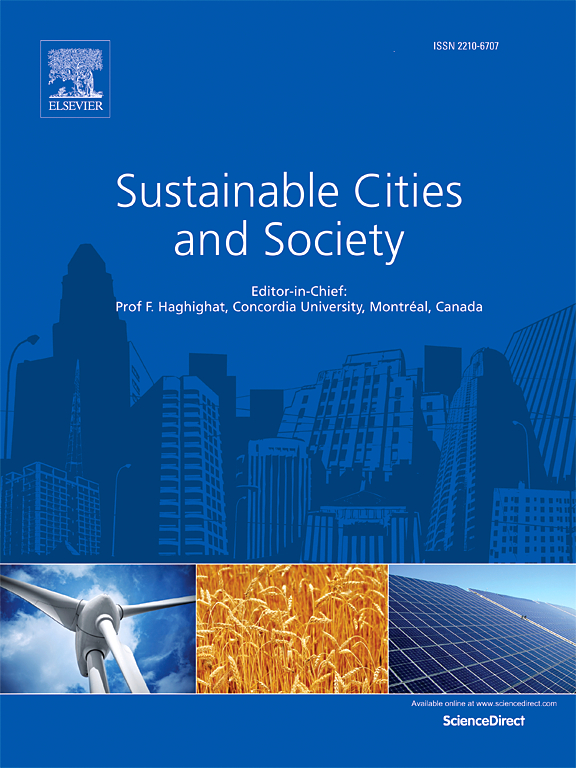利用图关注网络揭示城市土地利用模式对地表温度的影响
IF 10.5
1区 工程技术
Q1 CONSTRUCTION & BUILDING TECHNOLOGY
引用次数: 0
摘要
相当多的文献关注城市化导致的城市热岛效应的加剧。然而,地块间相互作用对地表温度的影响尚不清楚。本研究利用图注意力网络模型将土地利用(LU)模式表示为图结构,量化地块间的相互作用,并进一步研究其对LST的影响。结果表明,陆源对地表温度的强烈影响不仅来自陆源本身,也来自邻近地块。道路用地、工业/仓储用地和水域显著影响相邻地块的地表温度。行政用地、公园绿地、耕地、林地、草地对自身的影响较大。这种强烈的影响随拓扑距离(即顺序)而变化。商业用地对四个阶内焦点地块地表温度的影响随拓扑距离的增加而增大。最后,进一步明确了哪些类型的包裹受特定LUs的影响更大。这些研究结果将为城市规划的实施提供参考,以缓解城市热岛问题,促进城市可持续发展。本文章由计算机程序翻译,如有差异,请以英文原文为准。
Revealing the impact of urban land use patterns on land surface temperature through graph attention networks
A considerable body of literature focuses on the intensification of urban heat island effects (UHI) due to urbanization. However, the impacts of interactions between parcels on land surface temperature (LST) remains unclear. In this study, Graph Attention Networks model represented the land use (LU) pattern as a graph structure to quantify the interaction between parcels, and further investigated its impact on LST. The results elucidated the strong influence of LU on LST not only comes from itself but also adjacent parcels. Roadway land, industrial/storage land, and water significantly affect the LST of adjacent parcels. In contrast, administrative land, park/green space, arable land, forest land, and grassland had a stronger impact on themselves. This strong influence varies with the topological distance (namely, order). For instance, The influence of commercial land on the focal parcel' LST within the four orders increases with the rise in topological distances. Finally, it was further clarified which types of parcels were more affected by specific LUs. These findings would provide the implementation of the LU layout to mitigate the UHI and promote sustainable urban development.
求助全文
通过发布文献求助,成功后即可免费获取论文全文。
去求助
来源期刊

Sustainable Cities and Society
Social Sciences-Geography, Planning and Development
CiteScore
22.00
自引率
13.70%
发文量
810
审稿时长
27 days
期刊介绍:
Sustainable Cities and Society (SCS) is an international journal that focuses on fundamental and applied research to promote environmentally sustainable and socially resilient cities. The journal welcomes cross-cutting, multi-disciplinary research in various areas, including:
1. Smart cities and resilient environments;
2. Alternative/clean energy sources, energy distribution, distributed energy generation, and energy demand reduction/management;
3. Monitoring and improving air quality in built environment and cities (e.g., healthy built environment and air quality management);
4. Energy efficient, low/zero carbon, and green buildings/communities;
5. Climate change mitigation and adaptation in urban environments;
6. Green infrastructure and BMPs;
7. Environmental Footprint accounting and management;
8. Urban agriculture and forestry;
9. ICT, smart grid and intelligent infrastructure;
10. Urban design/planning, regulations, legislation, certification, economics, and policy;
11. Social aspects, impacts and resiliency of cities;
12. Behavior monitoring, analysis and change within urban communities;
13. Health monitoring and improvement;
14. Nexus issues related to sustainable cities and societies;
15. Smart city governance;
16. Decision Support Systems for trade-off and uncertainty analysis for improved management of cities and society;
17. Big data, machine learning, and artificial intelligence applications and case studies;
18. Critical infrastructure protection, including security, privacy, forensics, and reliability issues of cyber-physical systems.
19. Water footprint reduction and urban water distribution, harvesting, treatment, reuse and management;
20. Waste reduction and recycling;
21. Wastewater collection, treatment and recycling;
22. Smart, clean and healthy transportation systems and infrastructure;
 求助内容:
求助内容: 应助结果提醒方式:
应助结果提醒方式:


